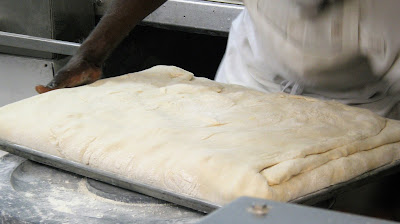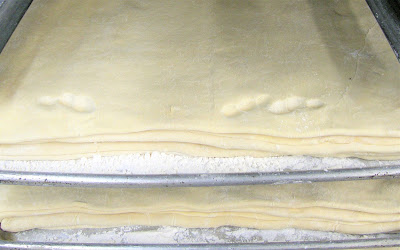What is Puff Pastry?
Puff Pastry, pâte feuilletée, masa de hojaldre, is a piece of art and bakery engineering altogether, since it is meant to self-rise without any chemical reaction such as baking powders nor yeast. The puff pastry is known as a laminated dough by the technique used to prepare it, that when baked has a light golden color, buttery flavor, airy appearance, and light sensation.
Depending on the ingredients used, it is also considered a vegan product due to the fact it does not contain any dairy product in it.
Nevertheless, the puff pastry uniqueness resides in its versatility in crossing frontiers, its flakiness, buttery rich flavor, and airy appearance, all of which provide the puff pastry the needed tools to spear across culinary cultures and recipes with a precise and undeniable importance as an ingredient in so many recipes.
The puff pastry dough simplicity in required ingredients is only the direct and inversely proportional of its labor-intensive manufacturing process, complex technique and the precision needed for perfection. The roadmap to reach its delicious texture needs lots of patience to master and care for a great and soft dough that once baked, will melt in your mouth while blending with the other ingredients used in the preparation .
What is Puff Pastry used for?
The puff pastry is a dry but buttery dough with many uses across all culinary cultures where it is used as an ingredient. As a French invention is the main ingredient for many French pastries both sweet and savory. Find below some of the most common recipes in which the puff pastry is needed:
Appetizers or starters: Quiches, Cheese straw, Pithivier, Pastelitos de picadillo, Sausage rolls;
Main dishes or Entrees: Volován or Vol-au-vent; Beef Wellington, Pig in a blankets;
Desserts: Profiteroles cake; Miguelitos, Mille-feuille, Strudels, Turnovers, Miloja (Milhoja), Pastelitos;
 Puff Pastry dough recipe
Puff Pastry dough recipe
Puff Pastry dough ingredients:
Here is a great vegan recipe, for you to prepare a delicious puff pastry dough
Baker wheat flour 100%
Salt 2%
Sugar 2%
Water 70%
Margarine 75%
Puff Pastry dough preparation
On top of a dry and clean surface, mix all dry ingredients and prepare a volcano shape.
Pour the water and mix. Do not blend homogeneously as a soft dough, let it to the point of “shredded dough”.
Cover the surface with a film of flour
Flatten evenly the dough on top the surface providing a square shape, applying a light pressure with hands.
“Paste” process:
Soften the margarine with hands.
Trace an imaginary line in your square dough dividing it in half.
Place margarine into one side, and cover your chosen side with the grease evenly, careful not reaching the borders of the dough.
Cover the margarine with the other half and apply pressure to the dough on the borders so both sides of the dough blend and avoid the grease from escaping.
Let the dough rest for some 30 min, covered with a humid towel. This resting process will be repeated after each folding in the laminating process, and it is paramount for both letting the dough rest and avoid stressing it, as well as to let the gluten work its magic.
Laminating process: there are 2 types of folding needed in the lamination process:
Simple folding or 3 layers: trace two imaginary lines dividing the dough in 3 faces equal in size, folding one side toward the middle and then the second side on top of the others.
- Double folding or 4 layers: trace one imaginary line in the middle of the square, and then two additional imaginary lines dividing each side of the dough in equal sizes.Fold each border toward the medium line, and then fold again the dough in the middle line.
- Alternating each one of the folding types, and letting in between each folding process a resting process, fold the dough 2 Simple folding and 2 double folding.
After each folding, with the roller, and without adding too much pressure toward the working surface, roll the roller to spread evenly the dough to reach the same sizes, and to the desired thickness. We recommend work with a 3mm thickness.
Cut the dough to the desired size to store or use.
When baking, do so at 350 °F for about 17-20 min until it puffs and does the layers.
What are you expecting from a good Puff Pastry?
- First and foremost, a flaky buttery flavored crunchy freshly baked puff pastry. That is the min you are going to obtain with our recipe. Don’t accept an oily waxy feeling in your mouth. That is just not right, that is because a cheap low quality grease was used in the preparation. Buttery is the flavor you are looking for.
You want a dry, light buttery consistency in your puff pastry dough, so you can add different fillings or toppings without losing the crispiness. You do not want to have an excessively dry flour taste in your dough. Watch out for the amount of water added to the dough and the spread of the grease between dough layers. Crispy and light, light and crispy. You want a perfectly puff, tall and thick, with consistently layers that intertwined and provide volume to the final product. You don’t want a chewy bread. If that is the issue, make sure the product is room temperature, preheat the oven and make sure you are not pressing the dough too much while doing the dough folding process.
Still no crispy? keep an eye on the pastry storage. A good puff pastry dough would last no less than 4 months frozen, and should be crispy for up to 10 hours after baked.
White pale pastries are usually those made by large manufacturers with no artisanal techniques.
Tricks and tips for a delicious and unforgettable Puff Pastry
The puff pastry dough remained us to our days in the professional services firms (we are lawyers and accountants), and the environment we always wanted to have when working in large Firms and the work environment we procured to provide to our employees: Chill and relaxing/Cool no rush/Steady but not over pressure.
Chill and relaxing: Dough and Room temperature: since you want to work with the grease as a layer and you don’t want to be integrated into the dough, you need to keep the dough as cool as possible. So, avoid overhandling when mixing, or with your hands and try to prepare the dough in a cool environment to avoid the grease to melt and pour out of the dough.
Cool no rush: Do not rush the process. Take your time to have it right, following the time constraints. Speeding up things will translate into a messy product. Don’t stress yourself, don’t stress the dough. Literally, keep it cool.
Steady but not over pressure: No one likes to be pressured while working, neither the puff pastry dough. You don’t want the layers to stick to each other, you want the butter to spread in between the dough layers.

When baking, here are some important tips:
Make sure the product is room temperature. Place the puff pastry on a baking paper and let it rest for a few minutes.
Egg wash
Preheat the oven at 350 °F
You’ll know puff pastries are ready when you can have them move on top of the baking paper without much effort.
When pastries are already baked, cover with some sugar syrup for a beautiful finish and place back in the oven for some 2 mins to glace it.


Comments
Post a Comment